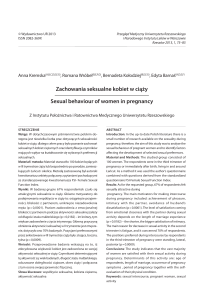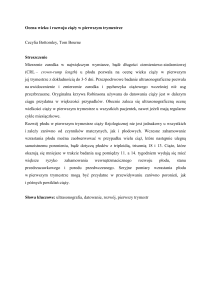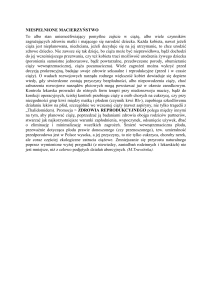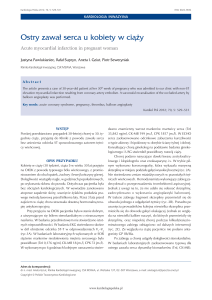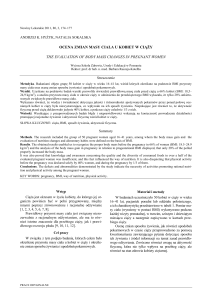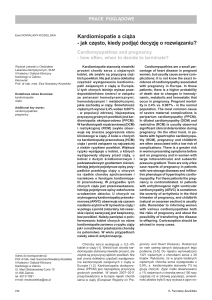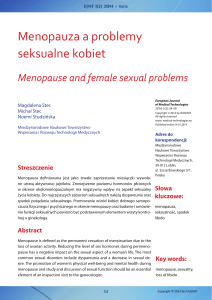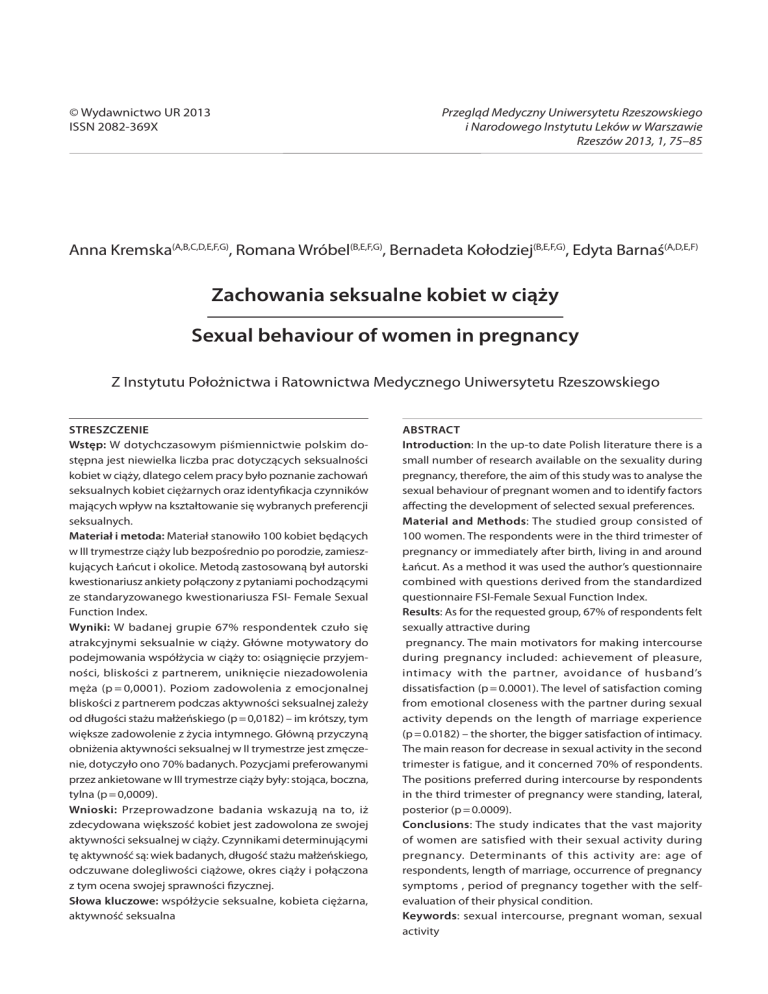
75
Kremska, Wróbel, Kołodziej, Barnaś Zachowania seksualne kobiet w ciąży
Przegląd Medyczny Uniwersytetu Rzeszowskiego
i Narodowego Instytutu Leków w Warszawie
Rzeszów 2013, 1, 75–85
© Wydawnictwo UR 2013
ISSN 2082-369X
Anna Kremska(A,B,C,D,E,F,G), Romana Wróbel(B,E,F,G), Bernadeta Kołodziej(B,E,F,G), Edyta Barnaś(A,D,E,F)
Zachowania seksualne kobiet w ciąży
Sexual behaviour of women in pregnancy
Z Instytutu Położnictwa i Ratownictwa Medycznego Uniwersytetu Rzeszowskiego
Streszczenie
Wstęp: W dotychczasowym piśmiennictwie polskim dostępna jest niewielka liczba prac dotyczących seksualności
kobiet w ciąży, dlatego celem pracy było poznanie zachowań
seksualnych kobiet ciężarnych oraz identyfikacja czynników
mających wpływ na kształtowanie się wybranych preferencji
seksualnych.
Materiał i metoda: Materiał stanowiło 100 kobiet będących
w III trymestrze ciąży lub bezpośrednio po porodzie, zamieszkujących Łańcut i okolice. Metodą zastosowaną był autorski
kwestionariusz ankiety połączony z pytaniami pochodzącymi
ze standaryzowanego kwestionariusza FSI- Female Sexual
Function Index.
Wyniki: W badanej grupie 67% respondentek czuło się
atrakcyjnymi seksualnie w ciąży. Główne motywatory do
podejmowania współżycia w ciąży to: osiągnięcie przyjemności, bliskości z partnerem, uniknięcie niezadowolenia
męża (p = 0,0001). Poziom zadowolenia z emocjonalnej
bliskości z partnerem podczas aktywności seksualnej zależy
od długości stażu małżeńskiego (p = 0,0182) – im krótszy, tym
większe zadowolenie z życia intymnego. Główną przyczyną
obniżenia aktywności seksualnej w II trymestrze jest zmęczenie, dotyczyło ono 70% badanych. Pozycjami preferowanymi
przez ankietowane w III trymestrze ciąży były: stojąca, boczna,
tylna (p = 0,0009).
Wnioski: Przeprowadzone badania wskazują na to, iż
zdecydowana większość kobiet jest zadowolona ze swojej
aktywności seksualnej w ciąży. Czynnikami determinującymi
tę aktywność są: wiek badanych, długość stażu małżeńskiego,
odczuwane dolegliwości ciążowe, okres ciąży i połączona
z tym ocena swojej sprawności fizycznej.
Słowa kluczowe: współżycie seksualne, kobieta ciężarna,
aktywność seksualna
Abstract
Introduction: In the up-to date Polish literature there is a
small number of research available on the sexuality during
pregnancy, therefore, the aim of this study was to analyse the
sexual behaviour of pregnant women and to identify factors
affecting the development of selected sexual preferences.
Material and Methods: The studied group consisted of
100 women. The respondents were in the third trimester of
pregnancy or immediately after birth, living in and around
Łańcut. As a method it was used the author’s questionnaire
combined with questions derived from the standardized
questionnaire FSI-Female Sexual Function Index.
Results: As for the requested group, 67% of respondents felt
sexually attractive during
pregnancy. The main motivators for making intercourse
during pregnancy included: achievement of pleasure,
intimacy with the partner, avoidance of husband’s
dissatisfaction (p = 0.0001). The level of satisfaction coming
from emotional closeness with the partner during sexual
activity depends on the length of marriage experience
(p = 0.0182) – the shorter, the bigger satisfaction of intimacy.
The main reason for decrease in sexual activity in the second
trimester is fatigue, and it concerned 70% of respondents.
The positions preferred during intercourse by respondents
in the third trimester of pregnancy were standing, lateral,
posterior (p = 0.0009).
Conclusions: The study indicates that the vast majority
of women are satisfied with their sexual activity during
pregnancy. Determinants of this activity are: age of
respondents, length of marriage, occurrence of pregnancy
symptoms , period of pregnancy together with the selfevaluation of their physical condition.
Keywords: sexual intercourse, pregnant woman, sexual
activity
76
Prz. Med. Uniw. Rzesz. Inst. Leków, 2013, 1, 75–85
Wstęp
Introduction
Fakt powołania do życia istoty ludzkiej i związana z tym
aktywność seksualna człowieka od zawsze były czymś
bardzo naturalnym, ale zarazem niezwykłym i tajemniczym. W literaturze seksualność jest definiowana jako
wrodzona funkcja organizmu ludzkiego; w aspekcie
psycho-społecznym jest tożsama z motywacją do podejmowania i kształtowania więzi i kontaktów interpersonalnych. Seksualność jako potencjał podlega wpływom
wielu czynników i jest kształtowana przez doświadczenia
życiowe. Wszechobecny trend manifestowania swoich
preferencji seksualnych, poprzez społeczną presję dla
akceptacji autonomii seksualności, jest również obserwowany wśród kobiet będących w związkach partnerskich.
Największą zmianą obserwowaną w tym zakresie jest
ewaluacja postaw kobiet, dla których seks stał się przyjemnością, a nie tylko obowiązkiem małżeńskim [1, 2].
W piśmiennictwie polskim liczba prac dotyczących
seksualności kobiet w ciąży jest niewielka, co sprawia, że
ta sfera życia seksualnego nie jest dostatecznie poznana,
zwłaszcza w kontekście psychologicznych uwarunkowań
reakcji seksualnych kobiet ciężarnych.
The fact of creating a human being and the related human
sexual activity have always been something very natural,
but also extraordinary and mysterious. According to the
literature, sexuality is defined as an innate feature of the
human body, and in terms of psycho-social meaning
it is the same as motivation for making and shaping
interpersonal relationships and contacts. Sexuality as the
potential is affected by many factors and is influenced by
life experiences. Pervasive trend manifesting their sexual
preferences through social pressure for the acceptance of
sexual autonomy, is also observed among women who
are in partnership. The greatest change observed in this
regard is evaluation of women attitudes for whom sex
has become a pleasure, and not only a marital duty [1,2].
The number of Polish literature on women sexuality
during pregnancy is small which makes that the area of
sexual life is not sufficiently understood, especially in
the context of the psychological determinants of sexual
response with regard to pregnant women.
Cel pracy
Celem pracy była ocena zachowań seksualnych kobiet ciężarnych oraz identyfikacja czynników mających wpływ na
kształtowanie się preferencji seksualnych podczas ciąży.
Materiał i metoda
Do badania prospektywnego włączono 120 kobiet.
Warunkami włączenia do badania były: III trymestr
ciąży lub stan kilku dni po odbytym porodzie, zgoda
osoby pełnoletniej na udział w badaniu lub w przypadku
braku pełnoletności zgoda osoby towarzyszącej będącej
prawnym opiekunem ciężarnej. Badane zostały poinformowane o celu i anonimowości badania. Badanie zaprojektowano w oparciu o standaryzowany kwestionariusz
ankiety FSI – Female Sexual Function Index, z którego
do autorskiego kwestionariusza dołączono kilka pytań
z poszczególnych płaszczyzn, dotyczących: pożądania,
podniecenia, lubrykacji, orgazmu, satysfakcji seksualnej.
Badanie przeprowadzono na terenie miasta Łańcut i w
jego okolicy, w miesiącach styczeń- luty- marzec 2010
roku. Do ostatecznej analizy wzięto pod uwagę 100 prawidłowo wypełnionych kwestionariuszy. Do opracowania
wyników użyto program statystyczny STATISTICA 8.0.
Wyniki
Wśród badanych przeważały respondentki w wieku 30
lat, natomiast średnia wieku ich partnerów wyniosła 33
lata. Porównując wiek badanych do wieku ich partnerów
wynika, że 90% ciężarnych było młodszych od partnera
o średnio 3,91 lat, jedynie 5% badanych było starszych od
partnera, zaś 5% populacji stanowili rówieśnicy. W zdecydowanej większości były to respondentki zamężne,
Aim of the study
The aim of this study was to assess the sexual behaviour
of pregnant women and to identify factors affecting the
development of sexual preferences during pregnancy.
Materials and methods
The prospective study enrolled 120 women. Conditions for
inclusion in the study were: third trimester of pregnancy
or the state held a few days after birth, the consent of an
adult to participate in the study or while she was still under
the age the consent of the legal guardian accompanying the
pregnant woman. The participants were informed about
the purpose of the study and its anonymity. The study
was designed on the basis of a standardized questionnaire
FSI-Female Sexual Function Index, which the authors of
the questionnaire enriched with several questions from
different fields concerning: desire, arousal, lubrication,
orgasm and sexual satisfaction. The study was conducted
in Łańcut town and its neighbouring, in the months of
January-February-March 2010. The final analysis took
into account 100 correctly completed questionnaires.
Results were developed by means of a statistical program
STATISTICA 8.0.
Results
As for the participants, the majority of them were in the
age of 30, while the average age of their partners was 33
years old. Comparing the age of the respondents to the
age of their partners shows that 90% of pregnant women
were younger than their partner with an average of 3.91
years, only 5% were older than a partner, and 5% of the
population were peers. The vast majority of respondents
were married, coming from the rural area, declaring
secondary education (Tab. I.).
77
Kremska, Wróbel, Kołodziej, Barnaś Zachowania seksualne kobiet w ciąży
Tab. I. Charakterystyka badanej grupy
Table I. Characteristics of the study group
Wyniki / Results
Wiek badanych
Age of the participants
Wiek partnerów
Age of the partners
Miejsce zamieszkania
Residence place
Wykształcenie
Education
Stan cywilny
Marital status
Me
x ±s
min-max
30
Me
30,14±5,9
17-43
min-max
x ±s
33,18±7,8
33
Miasto / City
37%
63%
Podstawowe / Primary Zawodowe / Vocational Średnie / Secondary
Wyższe / Higher
3%
28%
46%
23%
Mężatki / Married
Panny / Single
Rozwódki / Divorced
94%
5%
1%
Poczucie nieatrakcyjności w
ciąży
uniknięcie
niezadowolenia męża
bliskość z partnerem
Pow ód współżycia
dowód miłości
Poczucie atrakcyjności w ciąży
przyjemność
Liczba odpowiedzi
Powód podejmowania współżycia, a rodzaj uczuć dotyczących
atrakcyjności w ciąży
45
40
35
30
25
20
15
10
5
0
16-52
Wieś / Village
p = 0.0001
Liczba badanych –
Number of participants
red – feeling unattractive
during pregnancy
yellow – feeling attractive
during pregnancy
przyjemność – pleasure
bliskość – intimacy with
a partner
dowód miłości – token of love
uniknięcie niezadow. –
avoidance of husband’s
dissatisfaction
Ryc. 1. Powód podjęcia współżycia w ciąży a poczucie atrakcyjności w ciąży
Fig. 1. The reason of having intercourse during pregnancy and the sense of attractiveness during the pregnancy
pochodzące ze wsi, deklarujące średnie wykształcenie
(Tab. I.).
Najczęściej badane podejmowały współżycie podczas
ciąży po to, by: osiągnąć przyjemność, poczuć bliskość
z partnerem, ofiarować swoje ciało jako dowód miłości,
czy uniknąć niezadowolenia męża (p = 0,0001). Wszystkie
wyżej opisane czynniki determinują odczuwanie atrakcyjności wśród badanych (p = 0,0001) (ryc.1).
Wiek badanych w niewielkim stopniu zależy od poziomu odczuwanego pożądania (p = 0.0483) – większy
poziom pożądania odczuwają badane młodsze wiekiem
(ryc. 2).
Zdecydowanie częściej rozmowy na temat pożycia
seksualnego inicjują respondentki młodsze (p = 0,0092).
Dyskusje te są podejmowane ze swoimi partnerami
(ryc. 3).
Kolejno poproszono ankietowane o określenie częstości współżycia w zależności od czasu trwania ciąży.
Z zebranego materiału wynika, iż czas trwania ciąży
determinuje częstość kontaktów seksualnych w badanej
The most frequently reported reasons by the
participants to indulge in intercourse during pregnancy
were: pleasure achievement, feeling intimacy with
a partner, offering her body as a token of love, or avoidance
of husband’s dissatisfaction (p = 0.0001). All the above
factors determine the perception of attractiveness among
subjects (p = 0.0001) (Fig. 1).
Age of respondents to a small extent depends on
the perceived level of desire (p = 0.0483) – a higher level
of desire is reported by the surveyed women of younger
age (Figure 2).
Conversations concerning sexual life are more often
initiated by younger respondents (p = 0.0092). These
discussions are undertaken with their partners (Fig. 3).
The respondents were asked to identify the frequency
of intercourse, depending on the duration of pregnancy.
The collected data shows that the duration of pregnancy
determines the frequency of sexual intercourse in the
surveyed group (p = 0.0006). During the course of
pregnancy the participants reported more and more likely
78
Prz. Med. Uniw. Rzesz. Inst. Leków, 2013, 1, 75–85
p = 0.0483
Poziom pożądania a wiek kobiet ciężarnych [% ]
Liczba badanych –
Number of participants
Liczba badanych
120
16-20
100
21-25
80
26-30
60
31-35
40
36-40
20
41-45
0
bardzo
wysoki
wysoki
umiarkowany
niski
Poziom pożądania – Level of desire
bardzo wysoki – very high
wysoki – high
umiarkowany – moderate
niski – low
bardzo niski – very low
bardzo niski
Poziom pożądania
Ryc. 2. Wiek badanych a poziom pożądania, N = 100
Fig. 2. The age of respondents, and the level of desire, N = 100
p = 0.0092
Wiek badanych, a chęć podjęcia rozmów na temat
życia seksualnego. [%]
Liczba badanych –
Number of participants
120
Liczba badanych
100
80
często
60
rzadko
40
nie
często – often
rzadko – seldom
nie – none
20
0
16-20
21-25
26-30
31-35
36-40
41-45
Przedział w iekowy
Ryc. 3. Wiek badanych a chęć podjęcia rozmów na temat życia seksualnego
Fig. 3. The age of respondents, and their will to have interviews about the sexual life
grupie (p = 0,0006). Wraz z czasem trwania ciąży badane
chętniej podejmują aktywność seksualną, najwyższą
częstotliwość zarejestrowano w grupie ciężarnych w III
trymestrze ciąży – wyniosła ona średnio 4 zbliżenia
w miesiącu (Tab. II).
Poziom zadowolenia z uczuciowej bliskości z partnerem podczas aktywności seksualnej zależy od długości
stażu małżeństwa (p = 0,0182) – im krótszy staż małżeński
tym większe zadowolenie z życia intymnego (ryc. 4).
Kolejno zanalizowano zależność pomiędzy częstością
współżycia w II trymestrze ciąży a dolegliwościami ciążowymi. Istotnie taka relacja występuje w badanej grupie
(p = 0.0283) i dotyczy głównie kobiet odczuwających
zmęczenie w ciąży (ryc. 5).
Badając zależność pomiędzy częstością współżycia
w III trymestrze ciąży a czynnikami determinującymi
obniżone zainteresowanie seksem stwierdzono istotną
statystycznie zależność (p = 0.0253). Częściej dotyczyła
ona sytuacji związanych z niechęcią lub nieobecnością
partnera, obawą o dalszy przebieg ciąży, czy też obniżoną
samooceną swojej sprawności fizycznej (ryc. 6).
the engagement in sexual activity, and the highest rate
was recorded in a group of pregnant women in the third
trimester of pregnancy – it amounted to an average of 4
sexual acts in a month (Tab. II).
Level of satisfaction concerning the emotional
intimacy with the partner during sexual activity depends
on the length of marriage experience (p = 0.0182) - the
shorter length of marriage, the more satisfaction with
intimate life (Fig. 4).
Successively, the relationship between the frequency
of intercourse in the second trimester of pregnancy and
pregnancy symptoms was analysed. It turned out that
such a relationship really exists in the surveyed group
(p = 0.0283) and relates mainly to the women experiencing
fatigue in pregnancy (Fig. 5).
By examining the relationship between the frequency
of sexual intercourse during the third trimester of
pregnancy, and the factors determining reduced interest
in sex, it was noticed a statistically significant correlation
(p = 0.0253). It concerned more often the situation
79
Kremska, Wróbel, Kołodziej, Barnaś Zachowania seksualne kobiet w ciąży
Tab.II. Częstotliwość współżycia a okres ciąży
Table. II. The frequency of sexual intercourse and pregnancy
Czas trwania ciąży
Period of pregnancy
Me
x ±s
min-max
I trymestr
1st trimester
II trymestr
2nd trimester
III trymestr
3rd trimester
2
2,4±1,34
0-5
3
2,69±1,36
0-5
4
3,35±1,32
0-5
Staż małżeński, a zadowolenie kobiet
Staż małżeński
a zadowolenie bliskości
kobiet ciężarnych
ciężarnych
z emocjonalnej
podczas
z emocjonalnej bliskości podczas stosunku [%]
stosunku [% ]
Liczba odpowiedzi
120
bardzo zadowolona
100
umiarkowanie
zadowolona
80
60
zarówno zadowolona
i niezadowolona
40
20
0
0-5
6-10
11-15
16-20
21-25
Lata małżeństwa
umiarkowanie
niezadowolona
Test Chi2
p=0,0006
p = 0.0182
bardzo zadowolona – very
satisfied
umiarkowanie zadowolona
– moderately satisfied
zarówno zadowolona
i niezadowolona – both
moderately satisfied and
dissatisfied
umiarkowanie zadowolona
– moderately satisfied
bardzo niezadowolona –
very dissatisfied
bardzo
niezadowolona
Ryc. 4. Staż małżeński a zadowolenie kobiet ciężarnych z emocjonalnej bliskości podczas stosunku
Fig. 4. The length of marriage, and the satisfaction of pregnant women with emotional intimacy during sex
Wykazano istnienie zależności pomiędzy wiekiem
kobiet ciężarnych a podejmowaniem współżycia w III
trymestrze ciąży – zdecydowanie częściej współżyły
respondentki młodsze wiekiem (p = 0.0014) (ryc. 7).
W przypadkach, gdy ankietowane nie mogły
współżyć z partnerami z powodów położniczych w III
trymestrze ciąży poszukiwały one innych sposobów, aby
zaspokoić pożądanie partnera – wśród których dominowała technika manualnej stymulacji męskiego penisa
(p = 0,052) (ryc. 8).
Wykazano zależność pomiędzy wybieraną pozycją
seksualną a częstością współżycia - zdecydowanie częściej
badane w trzecim trymestrze ciąży odbywają stosunek
seksualny w pozycjach: stojącej, na boku i w pozycji tylnej
(p = 0.0009) (ryc. 9). Nie uzyskano znaczących zmian
w częstotliwościach zbliżeń, wybieraną pozycją a I i II
trymestrem czasu trwania ciąży.
Dyskusja
Potrzeba zaspokojenia seksualnego w przypadku prawidłowo przebiegającej ciąży utrzymuje się przez cały
okres jej trwania, chociaż w dużym stopniu zależy od
related to reluctance or absence of a partner, fear of the
subsequent course of pregnancy, or lowered self-esteem
of their physical fitness (Fig. 6).
The research demonstrated a relationship between
the age of pregnant women, and having intercourse
in the third trimester of pregnancy – the respondents
of younger age more often engaged in intercourse
(p = 0.0014) (Fig. 7).
In cases when respondents could not have intercourse
with the partners due to obstetric reasons in the third
trimester of pregnancy, they were looking for other ways to
satisfy the desire of the partner – they mainly mentioned
a technique of manual stimulation of the male’s penis
(p = 0.052) (Fig. 8).
The researchers noticed the relationship between the
chosen sexual position and frequency of intercourse – the
respondents mentioned more often the following sexual
positions chosen in the third trimester of pregnancy:
standing , lateral and posterior position (p = 0.0009)
(Fig. 9). No significant changes were shown in the
intercourse frequency, the chosen position as for the first
and second trimester of pregnancy.
80
Prz. Med. Uniw. Rzesz. Inst. Leków, 2013, 1, 75–85
Częstość
współżyciaw
w IIII trymestrze
trymestrze ciąży
a przyczyny
Częstść
współżycia
ciąży
a przyczyny
zmniejszonegozainteresowania
zainteresowania seksem
[%][% ]
zmniejszonego
seksem
Liczba odpowiedzi
poród przedwczesny
25
łożysko przodujące
20
zmęczenie
15
hospitacja
nieobecność męża
10
obawa o dziecko
5
0
codziennie kilka razy raz w tyg. kilka razy rzadziej
w tyg.
w mies.
wcale
Częstość współżycia
p = 0.0283
Liczba odpowiedzi – Number of answers
Częstość współżycia – Frequency of
intercourse
codziennie – every day / kilka razy
w tyg. – a few times a week / raz w tyg.
– once a week / kilka razy w mies. –
a few times a month / rzadziej – seldom / wcale – none
poród przedwczesny – preterm labour
/ łożysko przodujące / placenta praevia / zmęczenie – fatigue / hospitalizacja – hospitalisation / nieobecność
męża – husband’s absence/ obawa
o dziecko – fear of the baby
Ryc. 5. Częstość współżycia w II trymestrze ciąży a przyczyny zmniejszonego zainteresowania seksem
Fig. 5. The frequency of intercourse in the second trimester of pregnancy, and reason of reduced sexual interest
p = 0.0253
30
25
20
15
10
5
0
codziennie
niechęć męża
niezdarność
podczs stosunku
hospitacja(poród
przedwczesny)
niepokój
związany z
porodem
złe
samopoczucie
kilka razy w tyg.
obawa o dziecko
Liczba odpowiedzi
Przyczyny zmniejszonego
zmniejszonego zainteresowania
seksem
Przyczyny
zainteresowania
seksem a
częstośćwspółżycia
w
III
trymestrze
ciąży
a częstość współżycia w III trymestrze ciąży
raz w tyg.
kilka razy w mies.
rzadziej
w cale
Częstość współżycia
Liczba odpowiedzi – Number of answers
Częstość współżycia – Frequency of
intercourse
codziennie – every day / kilka razy
w tyg. – a few times a week / raz w tyg.
– once a week / kilka razy w mies. –
a few times a month / rzadziej – seldom
/ wcale – none
obawa… – fear of the baby / złe samopoczucie – bad feeling / niepokój …
– anxiety about labour / hospitacja…
– hospitalisation (preterm labour) /
niezdarność… – clumsiness during
intercourse / niechęć… – husband’s
reluctance
Ryc.6. Częstość współżycia w III trymestrze ciąży a przyczyny zmniejszonego zainteresowania seksem
Fig.6. The frequency of intercourse in the third trimester of pregnancy, and reason of reduced sexual interest
dotychczasowych doświadczeń i stopnia satysfakcji z pożycia intymnego. Popęd seksualny u kobiet ciężarnych
kształtuje się rozmaicie w zależności od przebiegu ciąży
i jej okresu.
W badaniu własnym zaprojektowanym jako badanie
prospektywne w grupie 120 kobiet podjęto próbę oceny
zachowań seksualnych kobiet ciężarnych oraz identyfikacji czynników mających wpływ na kształtowanie się
preferencji seksualnych podczas ciąży. Średnia wieku
badanych wyniosła 30,14 lat, a partnera seksualnego 33,18
lat. Wiek badanych w niewielkim stopniu wpływał na
poziom odczuwanego pożądania seksualnego, większe
nasilenie pożądania odczuwały badane młodsze wiekiem
(p = 0,0483). Problem odczuwania braku/spadku pożądania u ciężarnych został zaobserwowany w badaniach
Eryilmaza i wsp., gdzie w badanej populacji 55,9% kobiet
ciężarnych deklarowało jego brak [3]. Podobne wyniki
uzyskali Jiann i wsp., wykazując, iż niski poziom pożądania dotyka co 3. badaną ciężarną [4].
Discussion
The need for sexual satisfaction in case of pregnancy with
no complications lasts for the entire period of its duration,
although to a large extent it depends on the experience
and level of satisfaction with marital intimacy. Sexual
desire with regard to pregnant women is shaped differently
depending on the course of pregnancy and its period.
In our study, designed as a prospective study of 120
women in the group, the researchers attempted to assess
the sexual behaviour of pregnant women and to identify
factors affecting the development of sexual preferences
during pregnancy. The average age of the surveyed women
was 30.14 years old and as for their sexual partners the
average age was 33.18 years old. The age of respondents
only to a small extent affected the perceived level of sexual
desire, more intense desire was felt by younger women
(p = 0.0483). The problem linked with feeling lack/ drop
of desire considering pregnant women was observed in
the study of Eryilmaz and others, where 55.9% of the
81
Kremska, Wróbel, Kołodziej, Barnaś Zachowania seksualne kobiet w ciąży
p = 0.0014
Liczba odpowiedzi
Wiek
odawspółżycia
Wiek
współżycie w
w ciąży
ciąży [% ]
Wiek od współżycia w ciąży – Age and
having intercourse in pregnancy
40
35
30
25
20
15
10
5
0
Liczba odpowiedzi – Number of
answers
tak
nie
Wiek badanych – Age of the
respondents
tak – Yes / nie – No
16-20
21-25
26-30
31-35
36-40
41-45
Wiek badanych
Ryc. 7. Wiek badanych a podejmowanie współżycia w III trymestrze ciąży
Fig. 7. The age of respondents, and having intercourse in the third trimester of pregnancy
p = 0.0521
Aktywność seksualna w III trymestrze ciąży a sposoby
zaspokajania męża
[%]
150
Liczba
badanych
100
aktywne seksualnie w III
trymestrze
50
0
manualna stymulacja
penisa
oralna stymulacja
nieaktywne seksualnie w III
trymestrze
Sposób zaspokojenia męża
Aktywność seksualna w III tymestrze
ciąży a sposoby zaspokajania męża –
Decreased sexual activity in the third
trimester of pregnancy and the ways
satisfying the husband
Liczba badanych – Number of
participants
Sposób zaspokojenia męża – Ways
satisfying the husband
manualna stymulacja penisa – manual
stimulation of the penis / oralna
stymulacja – oral stimulation
aktywne seksualne w III trymestrze
– sexually active in the 3rd trimester /
nieaktywne seksualne w III trymestrze
– not sexually active in the 3rd
trimester
Ryc. 8. Obniżona aktywność seksualna w III trymestrze ciąży a zaspokajanie męża
Fig. 8. Decreased sexual activity in the third trimester of pregnancy, and satisfying the husband
p = 0.0009
Wybierane pozycje w III trymestrze ciąży a częstość
współżycia
[% ]
Liczba badanych
60
codziennie
50
kilka razy w tyg.
40
raz w tyg.
30
kilka razy w mies.
20
rzadziej
10
wcale
0
klasyczne
boczne
tylne
Rodzaj pozycji
na jeźdźca
stojące
Wybierane pozycje w III trymestrze
ciąży a częstość współżycia – Chosen
positions in the third trimester
of pregnancy and frequency of
intercourse
Liczba badanych – Number of answers
Rodzaj pozycji – Type of the position
klasyczne – classic / boczne – lateral /
tylne – posterior / na jeźdźca – riding /
stojące – standing
codziennie – every day / kilka razy
w tyg. – a few times a week / raz w tyg.
– once a week / kilka razy w mies. –
a few times a month / rzadziej –
seldom / wcale – none
Ryc. 9. Częstość współżycia w III trymestrze ciąży a rodzaj wybieranych pozycji
Fig. 9. The frequency of intercourse in the third trimester of pregnancy, and the type of selected position
82
Model reakcji seksualnych w ciąży według Lwa-Starowicza [2] ulega ewaluacji spowodowanej większą
świadomością seksualną społeczeństwa polskiego:
według autora wyraźnie wzrasta akceptacja kontaktów
oralnych (z 18% do 39% w okresie 1992–2005 r.),
również wyraźny trend wzrostowy zaobserwował
w aspekcie masturbowania (7% vs. 17%.) Badania
Polomeno wykazały, iż 40% francuskich kobiet odczuwało pragnienie stosunków analnych podczas trwania
ciąży. Autorzy uzasadniają to faktem zwiększenia libido
w ciąży u wielu par i deklarowaną chęcią urozmaicenia
swojego życia erotycznego o nowe doświadczenia [5].
W badaniu własnym wykazano, iż najczęstszą formą
zbliżeń seksualnych, przy braku przeciwwskazań medycznych, były stosunki waginalne. Tylko 13% badanych
deklarowało uprawianie seksu oralnego, 6% analnego,
a 4% masturbację. Najczęściej badane podejmowały
aktywność seksualną, ponieważ szukały przyjemności
dla siebie i partnera, a zbliżenia intymne traktowały
jako dowód miłości lub chęć uniknięcia niezadowolenia
męża (p = 0,0001). Interesujące są konkluzje polskich
autorów Łukasika i wsp., którzy wykazali, że kobiety
ciężarne niejednokrotnie decydują się na współżycie
tylko ze względu na swoich partnerów [6]. W badaniu
własnym 32% respondentek współżyło, aby uniknąć niezadowolenia partnera, traktując to jako dowód miłości
względem męża. W badaniu przeprowadzonym w grupie
347 ciężarnych kobiet tajlandzkich (średnia wieku 26,3
lat), połowa deklarowała, iż obawia się zbliżeń seksualnych ze względu na możliwość negatywnego wpływu
na rozwój płodu. W badanej populacji zaobserwowano
trend spadku zbliżeń seksualnych w ciąży, choć w 70%
nie zmniejszył się popęd płciowy [7].
Częstotliwość współżycia w ciąży niskiego ryzyka
była przedmiotem badań wielu autorów, większość
wykazała zmienną dynamikę zbliżeń seksualnych wraz
z czasem trwania ciąży. 150 ciężarnych z Instanbulu
deklarowało, że wraz z rozwojem ciąży rzadziej podejmowały aktywność seksualną, największe obawy
dotyczyły III trymestru ciąży, co przełożyło się również
na zmniejszenie czasu trwania stosunku i wzrostu niezdolności do przeżywania orgazmu [8]. Istotny spadek
częstości kontaktów seksualnych wraz z czasem trwania
ciąży zaobserwowali [9, 10, 11, 12, 13, 14]. Przekrojowe
badanie Erol’a i wsp. zaprojektowane, by znaleźć korelację pomiędzy aktywnością seksualną kobiet ciężarnych
a poziomem androgenów wykazało, iż spadek aktywności
seksualnej w II trymestrze wśród 589 badanych nie
korelował z niższym poziomem androgenów we krwi
obwodowej ciężarnych [15].
Zupełnie odmienny trend częstotliwości zbliżeń
intymnych otrzymano w badaniu własnym, gdzie wraz
z rozwojem ciąży wzrastała częstość kontaktów seksualnych, osiągając w III trymestrze średnią 3,35±1,32
(p = 0,0006). W związku z powyższym ciekawe wydaje się
Prz. Med. Uniw. Rzesz. Inst. Leków, 2013, 1, 75–85
population of pregnant women reported the absence of
desire [3]. Similar results were obtained by Jiann and
others showing that the low level of desire was experienced
by every third pregnant woman [4].
The model of sexual responses in pregnancy according
to Lew-Starowicz [2] has evaluated due to greater sexual
awareness of Polish society. According to the author
there is a clearly growing number for the acceptance
of oral contacts (from 18% to 39% in the period 1992
–2005), as well as a clearly increasing trend has been
observed in the aspect of masturbation (7% vs. 17%).
The studies conducted by Polomeno showed that 40% of
French women felt the desire for anal intercourse during
pregnancy. The authors justify that situation with the fact
of increased libido in pregnancy with regard to many
couples and declared desire to diversify their sex life with
new experiences [5]. In our study it was noticed that the
most common form of sexual intercourse (when there
were no medical contraindications) was the vaginal sex.
Only 13% of respondents reported engaging in oral sex,
6% in anal sex and 4% mentioned masturbation. The
surveyed women most frequently emphasised that they
have taken up sexual activities in order to find pleasure
for themselves and their partners and sexual intercourse
has been treated as a token of love or a wish to avoid her
husband›s dissatisfaction (p = 0.0001). Moreover, there are
interesting conclusions of Polish authors such as Łukasik
and others, who have showed that pregnant women often
decide to have intercourse only because of their partners
[6]. In our study, 32% of respondents had intercourse
to avoid partner’s dissatisfaction, treating it as a proof
of love with regard to her husband. In the study of 347
pregnant women from Thailand (average age 26.3 years),
half of them were afraid of sexual intercourse because
of the potential adverse effects on foetus development.
Considering the surveyed population, a decline trend has
been observed with regard to sexual intercourse during
pregnancy, although 70% did not report the decrease of
sexual drive [7].
Frequency of intercourse in low-risk pregnancy has
been investigated by many authors, and most of them
showed a variable dynamic of sexual intercourse with the
duration of pregnancy. 150 pregnant women from Istanbul
declared that with the development of pregnancy, they
engaged in sexual activity less often, and their biggest
concerns related to the third trimester of pregnancy, which
resulted in a reduction in the duration of the intercourse
and the growth of inability to experience orgasm [8].
A significant decrease in the frequency of sexual contacts
in the course of pregnancy was observed by [9, 10, 11,
12, 13, 14]. A cross-sectional study of Erol and others,
which was designed to find a correlation between sexual
activity of pregnant women and the level of androgens,
showed that the decline in sexual activity in the second
trimester with regard to 589 respondents did not correlate
Kremska, Wróbel, Kołodziej, Barnaś Zachowania seksualne kobiet w ciąży
pytanie: czy w badanej grupie występowały dolegliwości
ciążowe i czy miały one istotny wpływ na ograniczanie aktywności seksualnej? W I trymestrze ciąży nie zanotowano
wpływu dolegliwości na pożycie intymne, natomiast już
w II trymestrze niewielki wpływ zarejestrowano w grupie
badanych odczuwających zmęczenie (p = 0,0283), zaś
w III trymestrze było to związane z niechęcią lub nieobecnością partnera, lub obniżoną samooceną ze względu
na spadek sprawności fizycznej (p = 0,0253). Podobne
spostrzeżenie wysnuli Naldoni i wsp., którzy w grupie 137
kobiet będących w ciąży niskiego ryzyka zaobserwowali
spadek aktywności seksualnej wraz z rozwojem ciąży
i ograniczeniem sprawności spowodowanej nadmiernym przyrostem masy ciała ciężarnych [9]. Zjawisko
zmęczenia u ciężarnych było przedmiotem badań m.in.
Eryilmaza i wsp., którzy wykazali iż dotyczy ono 64%
badanych i jest przyczyną niechęci do podejmowania
aktywności seksualnej [3].
W badaniach Sipińskiego i wsp. aż 79% ciężarnych
deklarowało, iż postrzegają zmiany ciążowe obserwowane
w wyglądzie zewnętrznym jako korzystne, co przekładało
się na wysoką jakość ich pożycia seksualnego [16]. Pokrywa się to z opinią Polomeno, który twierdzi: jeśli kobieta
akceptuje zachodzące zmiany w swoim ciele, to czuje się
atrakcyjna seksualnie i to może się pozytywnie przekładać
na wzrost pożądania seksualnego [5]. Wyniki własne są
zgodne z tą opinią, bowiem możliwość współżycia seksualnego utwierdzało badane w poczuciu własnej atrakcyjności (p = 0,0001). Ogółem zadowolonych ze współżycia
seksualnego było 78% ciężarnych respondentek, podobne
wyniki otrzymali Naim i wsp. oraz Avis i wsp. [17,18].
Wyniki badań Pauls’a i wsp. uzyskane w grupie 63 kobiet
po porodzie pokazują, iż istotną rolę na spadek aktywności seksualnej w ciąży mają zaburzenia w postrzeganiu
swojego obrazu ciała, szczególnie mocno w tym badaniu
skorelowane z okresem poporodowym [19]. Nasilenie
reakcji lękowych w ciąży może być powodem obniżenia
popędu seksualnego, natomiast przyczyna zachowań
lękowych może być różna. Według Naima i wsp. prawie
połowa ciężarnych pakistańskich obawia się współżycia
w ciąży, ponieważ seks może zaszkodzić rozwijającemu
się płodowi [17]. Podobne stanowisko reprezentują ciężarne tajlandzkie, które w 47% obawiają się szkodliwego
wpływu na płód [7]. W badaniach Bartnickiej i wsp.,
gdzie 30–50% par pytanych o powody niepodejmowania
współżycia odpowiedziało, iż seks podczas ciąży może
zranić ich dziecko przebywające w macicy [20]. W badaniach Eryilmaza i wsp. 61,4% kobiet uważa, że współżycie
podczas ciąży zagraża w prawidłowym jej przebiegu [3].
Pojawienie się sytuacji położniczej w przebiegu ciąży,
uniemożliwiającej zbliżenia seksualne drogą pochwową
są wyzwaniem dla wielu par, które zmuszone są do stosowania innych form zaspokojenia potrzeb emocjonalnych
i seksualnych. W badaniu własnym ankietowane, które
z przyczyn położniczych znalazły się w takiej sytuacji,
83
with a lower level of androgens in peripheral blood of
pregnant women [15].
A completely different trend in the frequency of
sexual intercourse was obtained in our study, where
within the development of pregnancy sexual frequency
also increased, reaching in the third trimester the average
number of 3.35 ± 1.32 (p = 0.0006). Therefore, it seems
to be an interesting question whether the study group
experienced pregnancy healthy problems and whether
they had a significant impact on the reduction of sexual
activity? Considering the first trimester of pregnancy,
there was no effect of ailments on intimacy, but as for
the second trimester a little impact was recorded in the
surveyed group in the form of fatigue (p = 0.0283), while
in the third trimester it was associated with reluctance
or absence of a partner or low self-esteem due to lower
physical condition (p = 0.0253). Similar observation was
made by Naldoni and others, who observed a decrease
in sexual activity with the development of pregnancy and
reduced physical condition due to excessive weight gain
in the group of 137 women being at low risk of pregnancy
[9]. The phenomenon of fatigue during pregnancy was
the subject of research such as Eryilmaz and others, who
showed that it concerns 64% of surveyed women and is
the cause of reluctance to engage in sexual activity [3].
Considering the study conducted by Sipiński and
others, as many as 79% of pregnant women reported that
they perceive the changes during pregnancy observed in
appearance as an advantage, which corresponded with
their high quality of sex activity [16]. This coincides with
the opinion of Polomeno that says: if a woman accepts
the changes in her body, she feels sexually attractive
and it might correlate successfully with an increase
of sexual desire. [5] Our results are consistent with
this opinion, because the possibility of having sexual
intercourse confirmed the women in their own sense of
attractiveness (p = 0.0001). All in all, 78% of pregnant
respondents were satisfied with their sexual intercourse,
and similar results were obtained by Naim and others
as well as Avis and others [17, 18]. The results obtained
by Pauls and others after researching the group of 63
women after childbirth have shown that a significant role
in the decline in sexual activity during pregnancy is played
by a disturbance in the perception of their body image,
particularly correlated in this study with the postnatal
period [19]. Growing anxiety during pregnancy may
be the cause of low sex drive, however the cause of the
anxiety may be different. According to Naim and others,
almost half of pregnant Pakistani women fears engaging
in intercourse during pregnancy, because the sex can
harm the developing foetus. [17] A similar standpoint is
represented by pregnant Thai women who are afraid to
harm the foetus in 47% [7]. With regard to the study of
Brtnicka and others, 30–50% of surveyed couples asked
about the reasons for not having intercourse answered that
84
najczęściej stosowały techniki stymulacji męskich organów płciowych w celu rozładowania napięcia seksualnego
partnera (p = 0,052). Polomeno twierdzi, iż większość
par rekompensuje brak kontaktów seksualnych poprzez
bliskość (przytulanie się) i pocałunki [5].
Badane aktywne seksualnie w I i II trymestrze czasu
trwania ciąży zasadniczo nie modyfikowały swoich preferencji odnośnie do pozycji seksualnych (dominowały
boczna 30%; tylna 21% i klasyczna 25%). Natomiast
w III trymestrze ciąży stosunki seksualne zdecydowanie
częściej odbywały się w pozycji: stojącej, na boku i tylnej
(p = 0,0009). W badaniach Sipińskiego i wsp. w zdecydowanej większości ciężarne wybierały pozycję boczną
41%, klasyczną 26% oraz na jeźdźca 23% [16]. Natomiast
w badaniach Shoja i wsp. 45% kobiet w ciąży wybierało
pozycję tylną do współżycia [21]. Badania (4) ukazują
preferencje ciężarnych w doborze pozycji klasycznej i na
jeźdźca. Według Lee i wsp. ciężarne modyfikują pozycje
z klasycznej na tylną w III trymestrze ciąży [10]. Podobną
opinię wyrazili Wasinee i wsp., którzy uważają, iż podczas
ciąży dochodzi do zmiany preferowanych dotychczas
pozycji seksualnych na rzecz pozycji bezpiecznych,
wygodnych i tak większość kobiet pozycję na jeźdźca
zamieniły na boczną [22]. Zdaniem Polomeno wiele
kobiet preferuje pozycje tylne, a gdy ta pozycja staje się
niewygodna z powodu utrudnionego kąta wejścia, to
ciężarne decydują się na pozycję boczną [5].
Wnioski
1. Ciężarne w większości są zadowolone ze swojego
pożycia seksualnego, motywatorami do podejmowania aktywności są: chęć przyjemności i bliskości
z partnerem.
2. Wyższy poziom pożądania deklarują młodsze badane, z krótszym stażem partnerskim.
3. Wraz ze wzrostem ciąży wzrasta aktywność seksualna
badanych, zmianie ulegają również preferowane
przez ciężarne pozycje seksualne.
4. W grupie badanych, które ze względów położniczych
nie mogą współżyć istnieje tendencja do poszukiwania alternatywnych metod zaspokajania pożądania
partnera.
5. Czynnikami pozapołożniczymi ograniczającymi
aktywność seksualną są: zmęczenie, niechęć partnera, obawa o ciążę, obniżona samoocena sprawności
fizycznej.
Prz. Med. Uniw. Rzesz. Inst. Leków, 2013, 1, 75–85
sex during pregnancy could harm their child in the uterus
[20]. Regarding the study conducted by Eryilmaz and
others, 61.4% of women believe that sexual intercourse
during pregnancy endangers its correct development [3].
The appearance of the obstetric condition, which
makes the vaginal intercourse impossible, is a challenge
for many couples who are forced to use other forms to
satisfy their emotional and sexual needs. In our study, the
respondents who were in this situation due to obstetric
problems, mainly they applied techniques of male genital
stimulation in order to release sexual tension of the
partner (p = 0.052). Polomeno claims that most couples
compensate for the lack of sexual contact with intimacy
(hugging) and kisses [5].
The researched women who were sexually active in
the first and second trimester of pregnancy did not modify
their preferences for sexual positions (mainly lateral –
30%, posterior – 21%, and classic – 25%). However, in the
third trimester of pregnancy, sexual intercourse was more
often held in positions: standing, lateral and posterior
(p = 0.0009). As for the study carried out by Sipiński and
others, pregnant women in the vast majority chose lateral
41%, classic 26% and riding 23% positions [16]. However,
in the studies presented by Shoja and others, 45% of
pregnant women preferred the posterior position during
the intercourse [21]. The study (4) shows the preference
of pregnant women in the selection of classic and riding
positions. According to Lee and others, pregnant women
change from the classic to posterior position in the third
trimester of pregnancy [10]. A similar opinion was
expressed by Wasinee and others, who believe that during
pregnancy a change in the preferred sexual positions takes
place in order to create safe and comfortable positions,
and so most of the women exchange the riding position
for the lateral one [22]. According to Polomeno, many
women prefer the posterior position, and when this one
becomes uncomfortable because of the difficult angle of
the entry, pregnant women decide to assume the lateral
position [5].
Conclusions
1. Pregnant women in most cases are satisfied with
their sex life, and the things which motivate them to
engage in sexual activities are: the desire of pleasure
and intimacy with their partner.
2. A higher level of desire is declared by younger
surveyed women with shorter experience with the
partner.
3. Within the pregnancy development, sexual activity
of the researched women grows, as well as the
preferences with regard to sexual positions change.
4. In the group of surveyed women who cannot engage
in intercourse owing to obstetric reasons there is
a tendency to seek alternative methods of satisfying
partner’s desire.
85
Kremska, Wróbel, Kołodziej, Barnaś Zachowania seksualne kobiet w ciąży
5. Non-obstetric factors limiting sexual activity are:
fatigue, partner’s aversion, fear of pregnancy, reduced
self-esteem concerning physical fitness.
Piśmiennictwo / References
1. Lew- Starowicz Z. Seksualność, a jakość życia człowieka.
Przegląd Seksuologiczny 2006; 5: 26-29.
2. Lew- Starowicz Z. Seksualność Polek 1995-2005. Przegląd
Seksuologiczny 2005; 4: 19-23.
3. Eryilmaz G, Ege E, Zincir H. Factors affecting sexual life
during pregnancy in eastern Turkey. Gynecol Obstert Invest
2004; 57(2): 103-8.
4. Jiann BP, Su CC, Yu CC, Wu TT, Huang JK. Risk Factors
for Individual Domains of Female Sexual Function. J Sex
Med. 2009; 15: 321-45.
5. Polomeno V. Sex and Pregnancy: A Perinatal Educator’s
Guide. J Perinat Educ. 2000; 9(4): 15-27.
6. Łukasik R, Waksmańska W, Golańska Ż, Woś H. Różnice w
wyobrażeniach matki i ojca o życiu prenatalnym dziecka.
Probl. Pielęg. 2007; 15: 254-261.
7. Kerdarunsuksri A, Manusirivithaya S. Attitudes and sexual
function in Thai pregnant women. J Med Assoc Thai. 2010
Mar;93(3):265-71.
8. Gökyildiz S, Beji NK. The effects of pregnancy on sexual
life. J Sex Marital Ther. 2005 May-Jun;31:201-15.
9. Naldoni LM, Pazmiño MA, Pezzan PA, Pereira SB, Duarte
G, Ferreira CH. Evaluation of sexual function in Brazilian
pregnant women. J Sex Marital Ther. 2011 Mar;37(2):11629.
10. Lee JT, Lin CL, Wan GH, Liang CC. Sexual position and
sexual satisfaction of pregnant women. J Sex Marital Ther.
2010 Oct;36(5):408-20.
11. Senkumwong N, Chaovisitsaree S, Rugpao S, Chandrawongse W, Yanunto S. The changes of sexuality in Thai
women during pregnancy. J Med Assoc Thai. 2006 Oct;89
Suppl 4:S124-9.
12. Aslan G, Aslan D, Kizilyar A, Ispahi C, Esen A. A prospective analysis of sexual functions during pregnancy. Int J
Impot Res. 2005 Mar Apr;17(2):154-7.
13. Chang SR, Chen KH, Lin HH, Yu HJ. Comparison of
overall sexual function, sexual intercourse/activity, sexual
satisfaction, and sexual desire during the three trimesters
of pregnancy and assessment of their determinants. J
Sex Med. 2011 Oct;8(10):2859-67. doi: 10.1111/j.1743-6109.2011.02420.x. Epub 2011 Aug 3.
14. Fok WY, Chan LY, Yuen PM. Sexual behavior and activity
in Chinese pregnant women. Acta Obstet Gynecol Scand.
2005; 84(10): 934-8.
15. Erol B, Sanli O, Korkmaz D, Seyhan A, Akman T, Kadioglu A. A cross-sectional study of female sexual function
and dysfunction during pregnancy. J Sex Med. 2007
Sep;4(5):1381-7. Epub 2007 Jul 25.
16. Sipiński A, Kazimierczak M, Buchacz P, Sipińska K. Zachowania seksualne kobiet ciężarnych. Wiad. Lek. 2004;
LVII, supl. 1: 281-284.
17. Naim M, Bhutto E. Sexuality during pregnancy in Pakistani
women. J Pak Med Assoc. 2009; 50(1): 38-44.
18. Avis NE, Zhao X, Johannes CB, Ory M, Brockwell S, Greendale GA. Correlates of sexual function among multi-ethnic
middle-aged women: results from the Study of women’s
Health Across the Nation (SWAN). Menopause 2005; 12(4):
385-98.
19. Pauls RN, Occhino JA, Dryfhout VL. Effects of pregnancy
on female sexual function and body image: a prospective
study. J Sex Med. 2008 Aug;5(8):1915-22. Epub 2008 Jun 10.
20. Brtnicka H, Weiss P, Zverina J. Human sexuality during
pregnancy and the postpartum period. Bratisl Lek Listy.
2009; 110(7): 427-31.
21. Shojaa M, Jouybari L, Sanagoo A. The sexual activity during
pregnancy among a group of Iran women. Arch Gynecol &
Obstet 2009; 279(3): 353.
22. Wasinee U, Thanapan Ch. Sexuality and sexual activity in
pregnant women. J Med Assoc Thai 2004; 87(3): 45-9.
Adres do korespondencji / Mailing address:
Anna Kremska
Instytut Położnictwa i Ratownictwa Medycznego
ul. Pigonia 6, 35-310 Rzeszów
tel.: 665944433
e-mail: [email protected]

